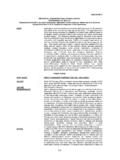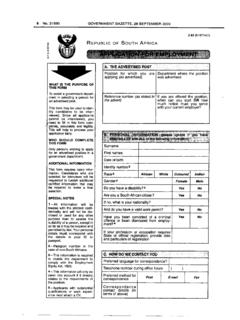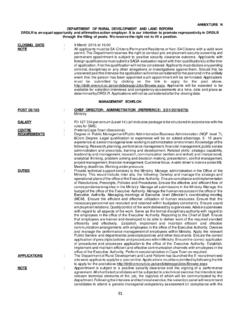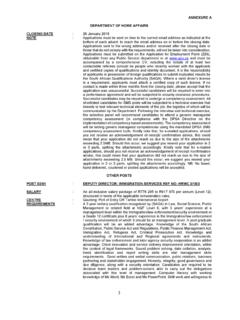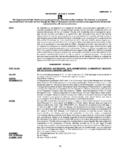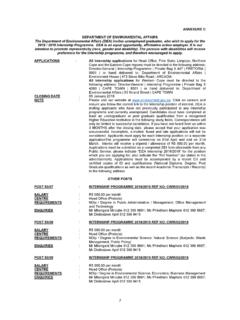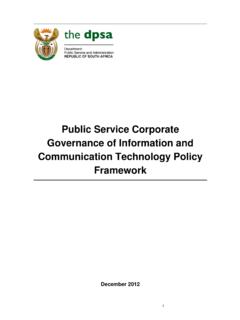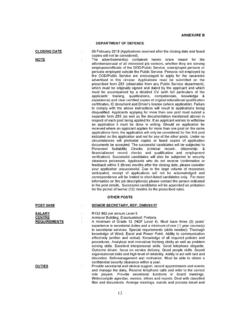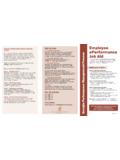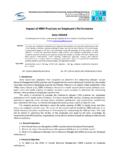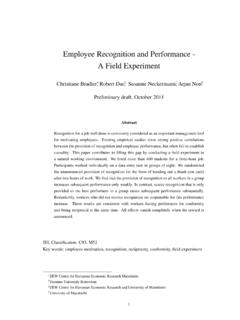Transcription of EMPLOYEE PERFORMANCE MANAGEMENT AND …
1 EMPLOYEE PERFORMANCE . MANAGEMENT AND DEVELOPMENT. SYSTEM. [EPMDS]. [Developed by the Department of Public Service and Administration as a framework for voluntary use by departments]. April 2007. EMPLOYEE PERFORMANCE MANAGEMENT AND DEVELOPMENT. SYSTEM (EPMDS). TABLE OF CONTENTS PAGE. Acronyms 4. Glossary of terms 5. INTRODUCTION 8. SCOPE AND APPLICATION 9. SOURCES OF AUTHORITY 9. AIMS OF PERFORMANCE MANAGEMENT 10. 10. Goal 10. Objectives 10. Principles THE PERFORMANCE CYCLE 11. PERFORMANCE PLANNING AND AGREEMENT 11. 11. The PERFORMANCE agreement The workplan 12. The personal development plan 13. Prolonged absence and staff movement 13. Amendments to the PERFORMANCE agreement 15. PERFORMANCE MONITORING, REVIEW AND ASSESSMENT 15. PERFORMANCE monitoring 15.
2 Categories of PERFORMANCE 15. Five point rating scale 16. PERFORMANCE review and assessment 16. Annual PERFORMANCE assessment 17. PERFORMANCE MODERATION 19. Normal distribution curve of PERFORMANCE categories 20. EPMDS April 2007 24/04/07. 2. TABLE OF CONTENTS PAGE. The intermediate review committee 21. Departmental Moderating Committee 21. Assessment Appeal Panel 22. Disagreements over rating and assessments 23. OUTCOMES OF PERFORMANCE ASSESSMENT 23. Probation 23. Managing PERFORMANCE that is not fully effective 24. Pay progression 24. Departmental PERFORMANCE incentive scheme 25. PERFORMANCE bonus 26. Budget for incentives 28. 28. Non-financial incentives 29. SYSTEM EVALUATION AND REVIEW. INSTITUTIONAL FRAMEWORK 30. ANNEXURES. Annexure A Template for the PERFORMANCE agreement Annexure B Guide to the PERFORMANCE workplan Annexure C Guide to generic assessment factors Annexure D Illustrative format for Personal Development Plan Annexure E Half-yearly review form Annexure F PERFORMANCE assessment instrument Annexure G Probation assessment form Annexure H Procedures for non-agreements on assessment EPMDS April 2007 24/04/07.
3 3. ACRONYMS. AAP Assessment Appeal Panel CAR Confirmed assessment rating (by DMC). CMC Core MANAGEMENT criteria DG Director-General DMC Departmental Moderating Committee DPSA Department of Public Service and Administration EA Executive Authority GAF Generic assessment factor HOD Head of Department HRD Human resource development HRM Human resource MANAGEMENT IRC Intermediate Review Committee KRA Key result area MEC Member of the Executive Council MMS Middle MANAGEMENT Service (as from 1 July 2005). MPSA Minister for the Public Service and Administration MTEF Medium Term Expenditure Framework PA PERFORMANCE agreement PAR Provisional assessment rating PDP Personal development plan PFMA Public Finance MANAGEMENT Act, 1999. PMDS PERFORMANCE MANAGEMENT and Development System PSA Public Service Act, 1994.
4 PSC Public Service Commission PSCBC Public Service Co-ordinating Bargaining Council PSR Public Service Regulations, 2001. SMS Senior MANAGEMENT Service SMS PMDS PERFORMANCE MANAGEMENT and Development System for the SMS. VAR Validated assessment rating (by CDAP). EPMDS April 2007 24/04/07. 4. GLOSSARY OF TERMS. Annual PERFORMANCE rating: The annual PERFORMANCE rating as part of an EMPLOYEE 's assessment that takes place at the end of the PERFORMANCE cycle. The result of this rating is the overall annual PERFORMANCE score for the EMPLOYEE during the entire PERFORMANCE cycle. Assessment instrument: An assessment tool used to assess the PERFORMANCE of an individual EMPLOYEE in relation to the achievement of key result areas and core MANAGEMENT criteria or generic assessment factors as contained in the workplan of the PERFORMANCE agreement.
5 Attribute: An attribute (as part of a competency) is generally defined to consist of motives, traits and self-concept. Competence: Relates to an EMPLOYEE 's capacity to meet the job requirements (job competence). Competency: A competency is a particular mix of knowledge, skills and attributes required to effectively perform a job/task/role. Confirmed assessment rating: The assessment score for an EMPLOYEE that has been confirmed by the departmental Moderating Committee (see also validated and provisional assessment rating). Core MANAGEMENT Criteria (CMC): An element of knowledge, skill, or attribute in the SMS. PMDS that is directly related to effective PERFORMANCE in a job, applicable to SMS members. Customers: People internal or external to the department with whom employees interact to provide a service.
6 Department: A department as defined in section 1 of the Public Service Act, 1994. Development: Training and development activities to enhance the EMPLOYEE 's competencies and to improve PERFORMANCE . Executive Authority: In relation to a department, government agency or institution, the President, a Minister, Premier or Member of the Executive Council. Feedback: Objective and timely information by the Director/supervisor on the EMPLOYEE 's PERFORMANCE against set expectations and standards, understood by the staff member, and aimed at improving PERFORMANCE . Generic Assessment Factor: An element used to describe and assess aspects of PERFORMANCE , taking into consideration knowledge, skills and attributes. Grievance rules: The rules for dealing with the grievances of employees in the Public Service, published by the Public Service Commission in Government Notice R 1012 of 25 July 2003, Government Gazette No.
7 25209. Incentive Policy Framework: Salary Level 1 to 12: DPSA circular 1/7/1/4/1, dated 27 January 2003: Implementation of an incentive policy framework linked to departmental PERFORMANCE MANAGEMENT systems for employees on salary levels 1 to 12.. EPMDS April 2007 24/04/07. 5. Integrated PERFORMANCE MANAGEMENT and Development System (IPMDS): A PERFORMANCE MANAGEMENT system developed by the DPSA in 2003 for voluntary use in the Public Service. Key Result Area (KRA): An area of a job in which PERFORMANCE is critical for making an effective contribution to the achievement of departmental strategies, goals and objectives Moderation: The review of EMPLOYEE assessment scores by a committee to ensure consistency and fairness across the department through a common understanding of PERFORMANCE standards required at each level of the rating scale and to assist in complying with the requirement that expenditure on bonuses should not exceed of the remuneration budget Operational plan(s) (or business plan).
8 A one-year plan derived from and giving life to the strategic plan by translating the strategic objectives identified in the strategic plan into key result areas and activities with measurable standards, for a particular year for the Department, Branches, Chief Directorates and Directorates. Outcome: A broad statement about a specific objective, aim or intent, the achievement of which will require one or more specific outputs to be achieved. Output: A concrete result or achievement ( a product, action or service) that contributes to the achievement of a key result area. PERFORMANCE : Human PERFORMANCE involves (1) EMPLOYEE actions, and (2) the outcomes or effects of those actions. PERFORMANCE is a process in which resources are used in an effective, efficient and productive way to produce results that satisfy requirements of time, quality and quantity, and which are the effect or outcome of the actions or behaviour of a performer in the work process.
9 PERFORMANCE agreement: A document agreed upon and signed by an EMPLOYEE and her or his supervisor, which includes a description of the job, selected KRAs and GAFs, a workplan and the EMPLOYEE 's personal development plan. PERFORMANCE appraisal/assessment: The measurement, assessment, rating or appraisal of EMPLOYEE PERFORMANCE . The formal annual process is usually referred to as PERFORMANCE appraisal or assessment, while more informal processes are referred to as PERFORMANCE review. PERFORMANCE cycle: A 12-month period for which PERFORMANCE is planned, managed and assessed. It must be aligned to the same period as the Department's annual business plan 1st April to 31st March of the following year. PERFORMANCE incentives: A set of (a) financial rewards linked to the results of PERFORMANCE appraisal, including pay progression, PERFORMANCE bonus, and (b) a variety of non-financial rewards that may be contained in the departmental PERFORMANCE incentive scheme.
10 PERFORMANCE incentive scheme: A departmental PERFORMANCE related incentive scheme aligned with its PERFORMANCE MANAGEMENT system, established in terms of PSR 1/VIII F and G. PERFORMANCE indicator: A measure used to gauge the extent to which an output has been achieved (policy developed, presentation delivered, service rendered). PERFORMANCE MANAGEMENT : A purposeful, continuous process aimed at managing and developing EMPLOYEE behaviour for the achievement of the organisation's strategic goals; the determination of the correct activities as well as the evaluation and recognition of the execution of tasks/duties with the aim of enhancing their efficiency and effectiveness; and a means of improving results from the Department, teams and individuals by managing PERFORMANCE within an agreed framework of planned goals, objectives, standards and incentives.
